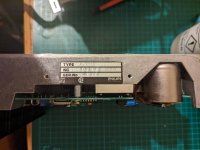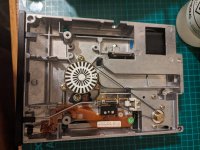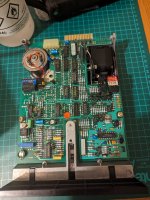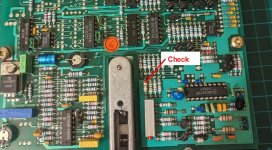Upcoming Events:
- VCF South West - June 14 - 16, Davidson-Gundy Alumni Center at University of Texas at Dallas
- VCF West - Aug 2 - 3, Computer History Museum, Mountain View, CA
- VCF Midwest - Sept 7 - 8 2024, Schaumburg, IL
- VCF SoCal - Mid February 2025, Location TBD, Southern CA
- VCF East - April 2025, Infoage Museum, Wall NJ
-
Please review our updated Terms and Rules here
You are using an out of date browser. It may not display this or other websites correctly.
You should upgrade or use an alternative browser.
You should upgrade or use an alternative browser.
Anyone recognise this Philips 5 1/4 floppy drive ?
- Thread starter zippysticks
- Start date
krebizfan
Veteran Member
Disk Trends has it as a 5.25" 40 track double density drive. Doesn't look like there is much that can be done with the jumpers since the other solder points don't have pins. Hopefully, it is set correctly. Philips did manufacture their own drives.
zippysticks
Veteran Member
Thanks - what is 'Disk Tends' please ? Its not something I have heard of.
The drive seems to work ok as drive 0, 40 track double sided double density (it has a terminating resistor pack installed) when connected to my Kryoflux. Was looking for any config info,
There are six sets of jumpers (plus one hard wired - and as you point out a bunch of solder pads) and I have no idea what they are for.
regards
The drive seems to work ok as drive 0, 40 track double sided double density (it has a terminating resistor pack installed) when connected to my Kryoflux. Was looking for any config info,
There are six sets of jumpers (plus one hard wired - and as you point out a bunch of solder pads) and I have no idea what they are for.
regards
krebizfan
Veteran Member
Disk Trends was a marketing forecast company that specialized in floppy drives and hard drives. They provided estimates of drives sold each year and a list of drive models. I use it for an initial check for drive type since it includes many manufacturers that more detailed sites don't bother with. Doesn't help with repairing drives though.
The only thing I could find was this page in german:
 forum.classic-computing.de
forum.classic-computing.de
Kennt jemand einen Rechner namens Philips P2500 ?? - VzEkC e. V.
Hallo,kann mir jemand was über den Philips P2500 (insbesondere welches Betriebssystem - TurboDOS ?) und welches Diskettenformat genutzt wurde (80Spuren, Single Sided, 32x 256Bytes Sektoren ?), erzählen ? Habe selbst eine Anfrage wg. dem Diskettenformat…
pbirkel@gmail.com
Veteran Member
Try: https://forum-classic--computing-de...r_tl=en&_x_tr_hl=en&_x_tr_pto=wapp#post192423
PS: Make sure that the settings at the top of the page are: German -> English
PS: Make sure that the settings at the top of the page are: German -> English
Hugo Holden
Veteran Member
It is easy to tell that this drive was European made, despite some American IC's. The clear blue sleeved electrolytic capacitors are Philips parts as are the yellow film capacitors. The green film types are ERO, common in European designs. Many of the transistors have the markings on the top surface, characteristic of Philips transistors of this era. Also, of you look on the bottom R hand edge of the pcb, those orange top grey ceramic capacitors are classic Philips parts. The resistors and signal diodes are Philips too.
Also, if you look at the pcb globally, the component layout is exceptionally orderly, this is typical of Philips designs. It is actually a really good thing, and a drive like this is well worth keeping and repairing. The Blue Tant caps may require replacing, but nothing else most likely.
Something is going on with one of the resistors which needs to be checked in case there is a defect.
Also, if you look at the pcb globally, the component layout is exceptionally orderly, this is typical of Philips designs. It is actually a really good thing, and a drive like this is well worth keeping and repairing. The Blue Tant caps may require replacing, but nothing else most likely.
Something is going on with one of the resistors which needs to be checked in case there is a defect.
Attachments
Last edited:
zippysticks
Veteran Member
Wunderbar ! Thats really useful - thanks. Gives some insight into the jumper config for drive selection and seems to indicated there is a schematic available for the drive.The only thing I could find was this page in german:
Kennt jemand einen Rechner namens Philips P2500 ?? - VzEkC e. V.
Hallo,kann mir jemand was über den Philips P2500 (insbesondere welches Betriebssystem - TurboDOS ?) und welches Diskettenformat genutzt wurde (80Spuren, Single Sided, 32x 256Bytes Sektoren ?), erzählen ? Habe selbst eine Anfrage wg. dem Diskettenformat…forum.classic-computing.de
Agreed. After a bit of searching through PDF's I couldn't locate a schematic, but maybe more digging will reveal it.seems to indicated there is a schematic available for the drive




